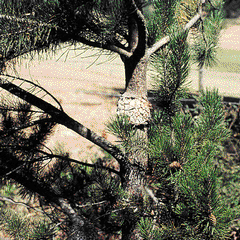
Rough, spherical swellings develop on branches or on the main trunk. In the spring, the swellings appear orange or yellow. Growth beyond the galls is often stunted, distorted, and off-color.

Rough, spherical swellings develop on branches or on the main trunk. In the spring, the swellings appear orange or yellow. Growth beyond the galls is often stunted, distorted, and off-color.
These plant diseases are caused by two species of fungi (Cronartium harknessii and C. quercuum). Western gall rust requires only one host to complete its life cycle; spores from one pine can infect another. Eastern gall rust requires both pine and oak to complete its life cycle. In early spring, orange or yellow spores are produced over the ruptured surfaces of the swellings (galls). The spores are blown and carried by wind and insects to susceptible trees. When moisture and temperatures are optimum, western gall rust spores infect pine tissue, causing an increase in the number and size of plant cells. Within 6 months to a year, swellings develop. The galls enlarge and produce spores after 1 to 2 years. Eastern gall rust spores infect only oak. Spores produced on the oak trees reinfect pines. The galls caused by both fungi interrupt the sap movement in the tree. They also stimulate witches'-brooms, dense stunted growth beyond the galls. If many of these develop the tree becomes unsightly and weak, and limbs break during storms.
Where practical, prune off galled branches before the galls produce spores in early spring.
Visit Books That Work at http://www.btw.com